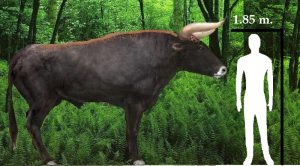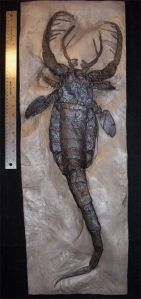Category Archives: Prehistoric Species
Organism of the Day: Aurochs!
Behold, the Aurochs (Bos primigenius)!
Daww, it’s so small and cute!
It’s…a cow. I know. BUT! It is not just any mere cow. For lo, it is the ancestor to all domestic cattle. These were organisms not to be trifled with. The Aurochs is a creature that shared the land with humans in Europe and Asia for may thousands of years. It was a large beast, and yet largely swift and agile. That, matched with it’s fiery temper, made for a terrifyingly deadly combination. It makes one wonder why our ancestors decided to try to domesticate these things at all! The Aurochs were spread far and wide, and had 3 distinct subspecies, shown here with their distributions.
The Aurochs was a forest dwelling bovine, with a diet that consisted of grass and leaves from trees. They played a pivotal role in the ecosystem of many of Europe’s forests, acting as the top-teir herbivores. Their absence has led to the forests falling out of balance, an issue that’s still being delt with today. So, how long has our species known these animals? Here’s a hint:
And you thought hammer pants were ancient.
The bulls on all the cave paintings we’ve found, like this one from Lascaux, France from 17,000 years ago, are all aurochs. They certainly do have a lot of meat on them, and were probably very enticing for our ancestors. Probably less enticing was their ability to hunt you down without tiring if you pissed them off. How do we know so much about this extinct species? Well, they haven’t been long gone. The last Aurochs died in Poland in the 1600’s. There’s plenty of historical data about them. When he wasn’t busy bringing down the wrath of Mars on the Gauls, even Julius Caesar wrote about them,
…those animals which are called uri. These are a little below the elephant in size, and of the appearance, color, and shape of a bull. Their strength and speed are extraordinary; they spare neither man nor wild beast which they have espied. These the Germans take with much pains in pits and kill them. The young men harden themselves with this exercise, and practice themselves in this sort of hunting, and those who have slain the greatest number of them, having produced the horns in public, to serve as evidence, receive great praise. But not even when taken very young can they be rendered familiar to men and tamed.
-Gallic War
Here’s an example of an extremely lucky man from the middle ages.
And a less fortunate Aurochs
So, why bring these creatures up? Because we’re bringing them back. The forests of Europe quite simply aren’t the same with out them, in a similar way Yellowstone National Park wasn’t the same without its keystone species, wolves. Beech trees are over-running the forests without the massive bovines. The TaurOs and Uruz Projects are using selective breeding to bring back a breed of cattle that can replace the aurochs and be very genetically similar. And they’re getting closer.
Note: I do not own these images.
Organism of the Day: Mixopterus
Today, I bring you the long extinct genus, Mixopterus. Because sometimes, Evolution dabbles with the fabric of Nightmares.
Click on it and play the music from Psycho for full effect!
This is the species Mixopterus kiaeri. Some of you may have questions like, “Is that thing a scorpion?”, “…is that monster is almost 2 feet long?”, “Will this hell-spawn haunt my waking dreams?”, or “HOLY CRAP! IS THAT A MURDER SPIKE ON IT’S TAIL????”. The answer to all of these questions are, respectively, maybe, yes, most likely, and ohhhhhhhhhhh yes it is. Thankfully, no human has ever come in contact with a living Mixopterus. It is now my great pleasure to inform you that it is dead, and has been dead, for 354 million years, and we had no idea of it’s existence until we found some in the rocks (the above comes from Norway). These things are part of the Order Eurypterida, which were scorpion-looking arthropods who roamed the vast seas of the Late Silurian Period. For reference, plants had just begun to come up on land, but animals were unheard of. That is part of what makes eurypterids so special; Some believe that they may have made short trips on land at a time where essentially no animals were up there. The body plan is that of a versatile predator. It had powerful muscles, legs, and paddle-like structures, meaning that it could walk on the ocean floor or swim to cover more distance. It’s spike was probably used to attack prey (some speculation says it may have had poison in it). They had large pincers, with long sharp spines, that could hold a prey down. The prey? Trilobites, a common arthropod for hundreds of millions of years. It is possible that this may be the ancestor of scorpions, which in my opinion, are a lot less terrifying than this dude, and, to be honest, slightly less badass.
I don’t own these images





